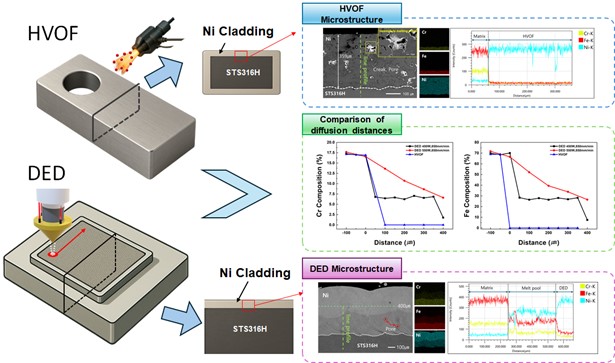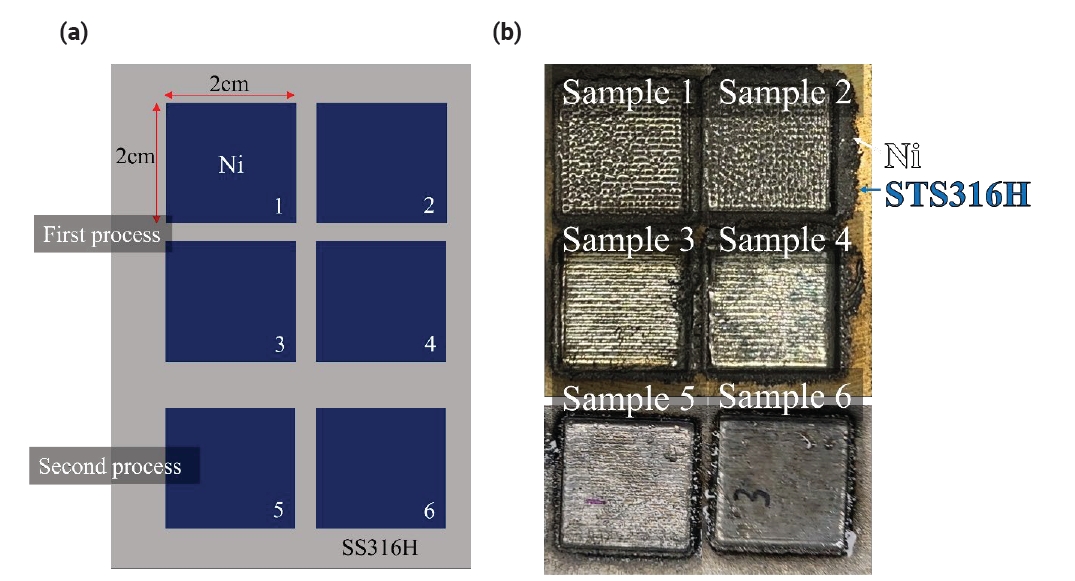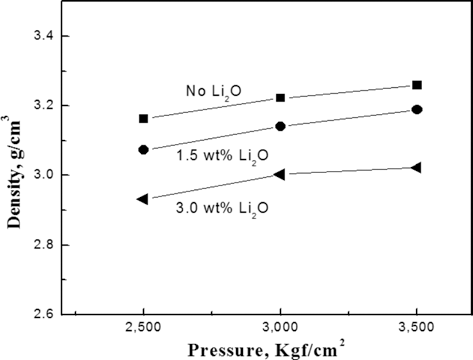Search
- Page Path
- HOME > Search
- [Korean]
- Evaluation of Mechanical Properties of Pure Ni Coatings on a Type 316H Stainless Steel Substrate via High-Velocity Oxy-fuel and Directed Energy Deposition Processes
- Won Chan Lee, Seung Ju Nam, Ji-Hyun Yoon, Jeoung Han Kim
- J Powder Mater. 2025;32(4):309-314. Published online August 29, 2025
- DOI: https://doi.org/10.4150/jpm.2025.00185

- 583 View
- 2 Download
-
 Abstract
Abstract
 PDF
PDF - This study compares pure Ni coatings deposited on type 316H stainless steel using high-velocity oxy-fuel (HVOF) and directed energy deposition (DED) processes. Microstructural analysis showed that DED produced more uniform claddings with fewer pores, while HVOF resulted in incomplete melting and cracks. Elemental diffusion of Cr and Fe from the substrate into the cladding was evident in DED samples, especially at higher laser power, but minimal in HVOF due to low heat input. Vickers hardness testing revealed that DED claddings had higher hardness near the interface, which was attributed to solid solution strengthening and reduced porosity. Although HVOF better suppressed diffusion, it exhibited inferior mechanical properties due to internal defects. Overall, the DED process demonstrated superior coating quality and mechanical performance, suggesting its suitability for corrosion-resistant applications requiring both structural integrity and thermal stability, such as molten salt reactors.
- [Korean]
- Study on the Elemental Diffusion Distance of a Pure Nickel Layer Additively Manufactured on 316H Stainless Steel
- UiJun Ko, Won Chan Lee, Gi Seung Shin, Ji-Hyun Yoon, Jeoung Han Kim
- J Powder Mater. 2024;31(3):220-225. Published online June 27, 2024
- DOI: https://doi.org/10.4150/jpm.2024.00164

- 1,045 View
- 42 Download
- 4 Citations
-
 Abstract
Abstract
 PDF
PDF - Molten salt reactors represent a promising advancement in nuclear technology due to their potential for enhanced safety, higher efficiency, and reduced nuclear waste. However, the development of structural materials that can survive under severe corrosion environments is crucial. In the present work, pure Ni was deposited on the surface of 316H stainless steel using a directed energy deposition (DED) process. This study aimed to fabricate pure Ni alloy layers on an STS316H alloy substrate. It was observed that low laser power during the deposition of pure Ni on the STS316H substrate could induce stacking defects such as surface irregularities and internal voids, which were confirmed through photographic and SEM analyses. Additionally, the diffusion of Fe and Cr elements from the STS316H substrate into the Ni layers was observed to decrease with increasing Ni deposition height. Analysis of the composition of Cr and Fe components within the Ni deposition structures allows for the prediction of properties such as the corrosion resistance of Ni.
-
Citations
Citations to this article as recorded by- Microstructural analysis and characterization of nickel deposition on 316H stainless steel via gas tungsten arc welding and powder laser cladding
Won Chan Lee, Jin Woong Park, Seung Ju Nam, Ji-Hyun Yoon, Jeoung Han Kim
Powder Metallurgy.2025; 68(4): 342. CrossRef - Effect of oxygen content in feedstock powders on microstructure and mechanical properties of ELI Ti-6Al-4V fabricated via laser powder bed fusion
Woo Hyeok Kim, Sang Woo Kim, Raj Narayan Hajra, Gargi Roy, Jeoung Han Kim
Powder Metallurgy.2025; 68(4): 307. CrossRef - Development of Aluminum Alloys for Additive Manufacturing Using Machine Learning
Sungbin An, Juyeon Han, Seoyeon Jeon, Dowon Kim, Jae Bok Seol, Hyunjoo Choi
Journal of Powder Materials.2025; 32(3): 202. CrossRef - Evaluation of Mechanical Properties of Pure Ni Coatings on a Type 316H Stainless Steel Substrate via High-Velocity Oxy-fuel and Directed Energy Deposition Processes
Won Chan Lee, Seung Ju Nam, Ji-Hyun Yoon, Jeoung Han Kim
Journal of Powder Materials.2025; 32(4): 309. CrossRef
- Microstructural analysis and characterization of nickel deposition on 316H stainless steel via gas tungsten arc welding and powder laser cladding
- [Korean]
- Effects of Li2O Addition and Heat-Treatment on Formability of FeS2 Powder for Cathode of Thermal Battery
- Sung-Soo Ryu, Won-Jin Lee, Seongwon Kim, Hae-Won Cheong, Sung-Baek Cho, Seung-Ho Kang, Sung-Min Lee
- J Korean Powder Metall Inst. 2014;21(3):185-190. Published online June 1, 2014
- DOI: https://doi.org/10.4150/KPMI.2014.21.3.185

- 442 View
- 4 Download
- 1 Citations
-
 Abstract
Abstract
 PDF
PDF FeS2 has been widely used for cathode materials in thermal battery because of its high stability and current capability at high operation temperature. Salts such as a LiCl-KCl were added as a binder for improving electrical performance and formability of FeS2 cathode powder. In this study, the effects of the addition of Li2O in LiCl-KCl binder on the formability of FeS2 powder compact were investigated. With the increasing amount of Li2O addition to LiCl-KCl binder salts, the strength of the pressed compacts increased considerably when the powder mixture were pre-heat-treated above 350°C. The heat-treatment resulted in promoting the coating coverage of FeS2 particles by the salts as Li2O was added. The observed coating as Li2O addition might be attributed to the enhanced wettability of the salt rather than its reduced melting temperature. The high strength of compacts by the Li2O addition and pre-heat-treatment could improve the formability of FeS2 raw materials.
-
Citations
Citations to this article as recorded by- Effects of Particle Size and Binder Phase Addition on Formability of Li-Si Alloy Powder for Thermal Battery Anode
Sung-Soo Ryu, Hui-Sik Kim, Seongwon Kim, Hyung-Tae Kim, Hae-Won Cheong, Sung-Min Lee
Journal of Korean Powder Metallurgy Institute.2014; 21(5): 331. CrossRef
- Effects of Particle Size and Binder Phase Addition on Formability of Li-Si Alloy Powder for Thermal Battery Anode
TOP
 kpmi
kpmi


 First
First Prev
Prev


